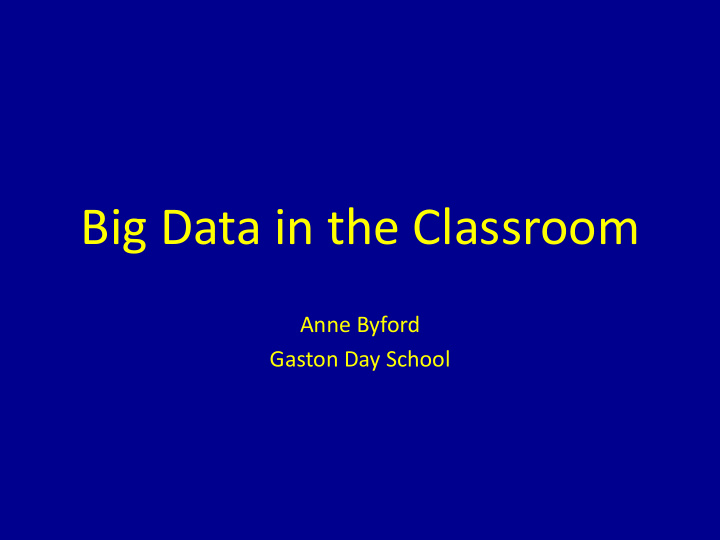



Big Data in the Classroom Anne Byford Gaston Day School
Why Big Data? • Producing data is EASY! – InternetLiveStats (per second): • 808 Instagram, 7796 Tweets, 71,208 YouTubes watched • Knowing what to do with data is HARD • According to Forbes.com: – Wide range of fields from health care to retail – Median Salary (with experience): 124,000 – % Demand growth: up to 300% in one year
Why Big Data? • Datasets available (and free) for many subjects, not just science • Ideal for Project-based learning – Authentic data, authentic tools • Adaptable for differentiation – Same data set can be used with different questions – Curated data provided to some groups
Skills Used • Background research • Question development • Data organization – What data to I need to answer my question? – What should my table look like? – What information should I compare? • Data analysis – What does this data mean? – What statistics should I do and what to they mean?
Skills Used • Data visualization – Graphs, Tables, other Figures • Communication – Oral Presentation – Written Presentation – Website Development – Poster Session
Cautions: • Using “real” data – Can be complex – Is often messy – May not give the expected answer – Takes more time than “canned data” • Students will need help with specific skills – Asking good questions – Using spreadsheets, both set-up and graphing – Relating raw data to their questions • Students will experience frustration – Especially those used to getting right answers immediately
Zooniverse.org
HHMI Wildcam Gorongosa • Lesson plans already developed • Segments include – Making observations – Scientific inquiry and data analysis – Biodiversity – Ecological Pyramids • Entire sets of raw camera and animal identification data available for download
Other Sources of Data • NOAA – https://www.ncdc.noaa.gov/ • CDC and WHO – https://data.cdc.gov/ – http://www.who.int/gho/database/en/ • NASA data – https://data.nasa.gov/
DNA to Proteins Project • Based on: – Salt Lake City Community College’s Halobacterium project – http://www.slcc.edu/biotech/halo-project/index.aspx • Students – analyze 50,000bp DNA to identify ORFs – Build a consensus ORF map – Analyze an ORF to determine if it is a gene and its potential function • Files in shared Google folder
Sea Scallop Project • Developed during Teacher-At-Sea (NOAA) • Raw data from yearly Sea Scallop Survey – Data from 1979 – 2016 – Fish Species catch number and mass – Scallop catch number, size, and mass – Location of all dredge sites (lat/long) • Full lesson plan in shared folder
Link to Project Folder • https://drive.google.com/drive/folders/0B9tW i0CfAPdZOGVtcmdHckpCS3M?usp=sharing
Recommend
More recommend